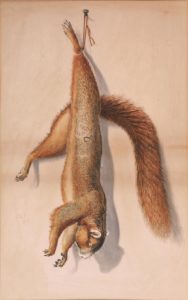Achille Perelli
Italian-born sculptor Achille Perelli was an active participant in the New Orleans arts scene from 1850 to 1891.

Courtesy of Neal Auction Company
Nature Morte: Red Squirrel. Perelli, Achille (Artist)
Torn in Milan, Italy, on March 7, 1822, Achille Perelli was an active participant in the New Orleans arts scene from 1850 to 1891. His training took place in Italy with the Italian sculptor Galli and at the Academia di Belle Arti in Milan, but he was forced to flee his native country shortly after the defeat of Garibaldi, under whom he had served in the Italian revolution of 1848. He was initially known as a sculptor of marble, but later he was celebrated for his paintings of birds, fish, and other small game native to South Louisiana and Florida. His watercolors of natures mortes, such as Mallard, Passenger Pigeon, and Red Squirrel, are well known today. He was also a respected professor of drawing at the Southern Art Union from 1881 to 1884, and of sculpture and modeling at the Artists’ Association of New Orleans from 1890 to 1891.
After traveling around his adopted country, Perelli elected to make his home in New Orleans. It is reported that he chose the city because he liked the scenery. By the mid-nineteenth century, he was identified there as an accomplished sculptor. At a time when there was a paucity of American sculptors, because most were establishing studios overseas in Florence or Rome, Italy, Perelli was often called upon to produce busts, statues, and medallions of public figures such as Major Gally (1851), Winfield Scott (1852), P. G. T. Beauregard (1861), and Abraham Lincoln. He submitted a model to the Jackson Monument Committee for a full-scale equestrian figure of Andrew Jackson to be placed in Lafayette Square in Washington, D.C., opposite the White House (an identical model was later placed at New Orleans’ Jackson Square). Although Perelli’s submission received praise, he lost the commission to a sculpture by Clark Mills. With other artists, Perelli worked to find an appropriate site for an improved Henry Clay monument in 1860, which was eventually erected on the neutral ground of Canal and Royal Streets.
Recognizing Perelli’s talents, New Orleans honored him by making him the first sculptor living in the city to be commissioned to produce significant civic monuments, particularly those of Confederate military leaders. His busts of generals Robert E. Lee and Stonewall Jackson (1872) were studies for the Monument to the Confederate Dead placed in Greenwood Cemetery in 1874. Around that same time, the Dante Lodge of Freemasons, of which he was a member, commissioned him to make a bronze bust of the poet Dante for the lodge’s tomb in St. Louis Cemetery in New Orleans. Perhaps his most significant sculpture was another Civil War monument, a statue of Stonewall Jackson commissioned by the Association of the Louisiana Division of the Army of Northern Virginia in 1880. It was placed on top of the Association’s tomb in Metairie Cemetery in New Orleans. Later, Perelli added a bronze insignia for the entrance to the tomb of the Army of Tennessee in the same location.
In the 1870s, Perelli’s interest turned to making watercolors and pastels of natures mortes, which often took as their subjects local wildlife. An avid sportsman himself, his practice was to catch a small animal, a bird or fish, then bring it back to his studio to make drawings of it while it was still lifelike. The accuracy of the works was highly valued by New Orleanians, who frequently purchased them to hang in their homes. After his death on October 9, 1891, his four sons opened his studio for a public viewing and sale of his remaining paintings and sculptures. The press reported that “off to one side was a museum of Natural History, complete and interesting, with the varied specimens indispensable to the true artist.”
Perelli’s work appeared frequently in exhibitions as well as in private homes. His renderings of local wildlife were often hung alongside his paintings of Louisiana landscapes. As early as 1850, they were shown at the New Commercial Exchange, and in 1851 at the Union Gallery of Fine Arts. Other exhibitions included shows at Charleville’s gun store (1873), Wagener’s (1877), Seebold’s (1880 and 1884), the Southern Art Union (1881), the American Exposition (1885–1886), the Artists’ Association of New Orleans (1886–1887 and 1889–1890), and Tulane University (1890).
An active member of New Orleans’ arts organizations, Perelli worked with Andres Molinary and Bror Anders Wikstrom to organize the Southern Art Union in 1881. He served as the drawing teacher there until it failed. When the Artists’ Association of New Orleans replaced a defunct Southern Art Union, he continued his teaching with the new organization and exhibited his work in its annual exhibitions.
Achille Perelli died of throat cancer on October 9, 1891. He is buried in St. Louis Cemetery No. 3. Today, his work is represented in the collections of the US Capitol, the New Orleans Museum of Art, the Louisiana State Museum, and many private collections.
